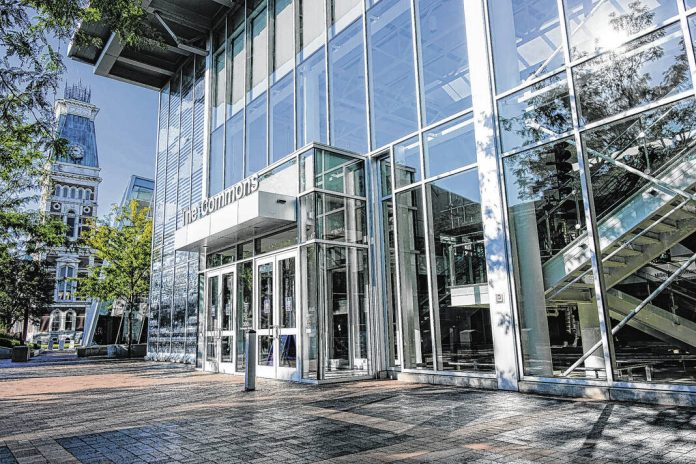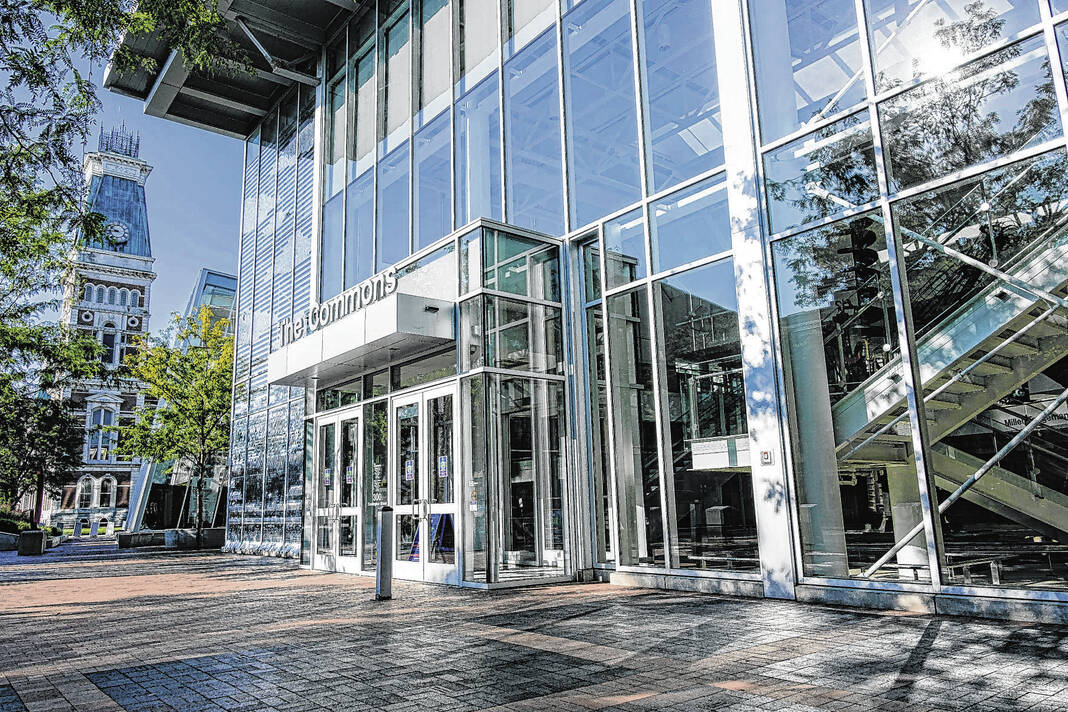
Mike Wolanin | The Republic An exterior view of The Commons in downtown Columbus, Ind., Wednesday, Sept. 8, 2021.
Population growth in Bartholomew County has largely been driven by international migration since the pandemic struck, with the county’s population exceeding pre-pandemic levels and reaching an all-time high last year, according to new estimates from the U.S. Census Bureau.
Bartholomew County’s population expanded by nearly 1,800 people from April 1, 2020, to July 1, 2023, eclipsing 84,000 people last year for the first time ever, the new estimates show. That represents a growth rate of 2.2% from 2020 to 2023.
International migration — the number of people moving into Bartholomew County from outside the U.S. minus the number of people leaving — was 1,500 over the same period. At the same time, 295 more domestic residents moved out of the county than moved in.
Natural growth — the number of births minus the number of deaths — also added an additional 541 new residents.
As of this past July, Bartholomew County’s population had surpassed the 2019 estimate of 83,779 for the first time since the county experienced a significant population decline when the pandemic struck. In 2020, the county’s population fell by 1,568 people.
“Except for that 2020 period when we dropped a bunch of folks, we’ve shown reasonable growth,” said Steve Mohler, assistant professor of management at IU Columbus. “…(Immigration) is good for our economic growth, good for our community.”
Highly skilled workers
Experts and researchers say international migration in Bartholomew County is largely following trends playing out across the state and country since the pandemic struck.
The vast majority of U.S. population growth from 2020 to 2023 was fueled by immigration, which accounted for 74% of the population increase over that period. Net international migration in Indiana was 39,751, representing nearly 52% of the state’s population growth over the period.
“International migration is probably the largest driver of population growth in the state over the last couple of years, but maybe not quite to the extent that you see in Bartholomew County,” said Matt Kinghorn, senior demographic analyst at the Indiana Business Research Center at the Indiana University Kelley School of Business.
Locally, international migration is largely driven by local employers who are seeking highly skilled workers they need to grow their businesses, experts said.
Federal immigration records show that employers in Columbus have set their sights overseas to recruit and hire highly skilled workers in areas where there are labor shortages, particularly through the H-1B visa program. Some of those areas include engineering, technology and finance, among others.
A total of 24 employers with offices in Columbus received approvals for a collective 2,465 H-1B visas for highly skilled workers from fiscal year 2021 to fiscal year 2023, which ran from Oct. 1, 2020, to Sept. 30, 2023, according the U.S. Immigration and Citizen Services, or USCIS.
Cummins Inc., which is headquartered in Columbus and is the largest employer in the area, received approvals for 2,135 H-1B visas over that period. However, it is hard to saw how many of those workers wound up living or working in Bartholomew County, as Cummins has offices in several states.
Other local employers that received visa approvals included LHP, Toyota Material Handling, Faurecia, LER TechForce, Dorel Juvenile Group, Columbus Regional Health, Grace Lutheran Church, among others.
“We have a lot of international folks on H-1B visas, and that has proven to be good economically for our community,” Mohler said. “…Indiana is not known for our higher education attainment.
“The recent push in the U.S. for STEM education is reflective of a deficit in that area,” Mohler added. “We have a deficit of STEM-educated folks in the U.S. …Engineering, science, technology, (companies are) bringing in people from other countries to fulfill those roles where we don’t have the training in those areas.”
Mostly from Asia
While half of the foreign-born population in the U.S. come from Latin America, nearly 60% of Bartholomew County’s foreign-born residents are from Asia, according to U.S. Census Bureau estimates that were current as of 2022.
Additionally, Bartholomew County’s foreign-born population tends to be more highly educated and make more money than the county’s native-born population.
In 2022, nearly 68% of foreign-born residents in the county had at least a bachelor’s degree, including 44% who had a graduate or professional degree, according to the U.S. Census Bureau. By comparison, about 30% of the county’s native-born population had at least a bachelor’s degree, with 10% having a graduate or professional degree.
At the same time, median annual income for foreign-born women in Bartholomew County was $88,762 in 2022, while median annual income for foreign-born men was $88,312. By comparison, median annual income for a native-born men in Bartholomew County was $64,543 and $47,048 for native-born women.
Yet foreign-born residents are much more likely to rent a home than native-born residents despite generally making more money. In 2022, 61% of foreign-born residents in the county were renting a home or apartment, compared to 25% of native-born residents.
Overall, the county has continued to grow more diverse, with the percentage of Bartholomew County residents who were born in another country climbing from 4% in 2000 to about 10% in 2022, according to the U.S. Census Bureau.
“Those H-1B visas, they are drawing in educated folks, and educated folks have an overall positive impact on economic growth,” Mohler said.
“There’s research that shows that people with bachelor’s degrees or higher produce a lot more income,” Mohler added. “…The higher income leads to higher (tax revenue), higher spending, a lot of positives for our community.”
Immigration likely to continue
Researchers say increased international migration is likely a sign of things to come. Without immigration, the U.S. population is projected to decline as deaths are forecast to outpace births by the late 2030s, particularly as Baby Boomers continue to age and the already-tight labor market grows even tighter.
Locally, about 23% of Bartholomew County residents were at least 60 years old in 2022, up from 20% in 2010 and 16% in 2000, according to the U.S. Census Bureau. Deaths per capita were already ticking up in the county before the pandemic struck and have continued to inch up after the pandemic receded.
At the same time, the number of children born to Bartholomew County women each year barely changed from 1990 to 2021, ticking up just 1.5% even as the population of females ages 15 to 44 grew 13% over that period.
“Just looking at the big picture, as the state’s population continues to age, as the Baby Boomer generation continues to age, we’re expecting to see labor force growth slow significantly over the next 10 to 20 years,” Kinghorn said. “…That’s not great news for our employers. As we move ahead, I think attracting young adults is going to play an increasingly important role for Indiana’s economy. And I think international migration will be a big piece of that puzzle.”







